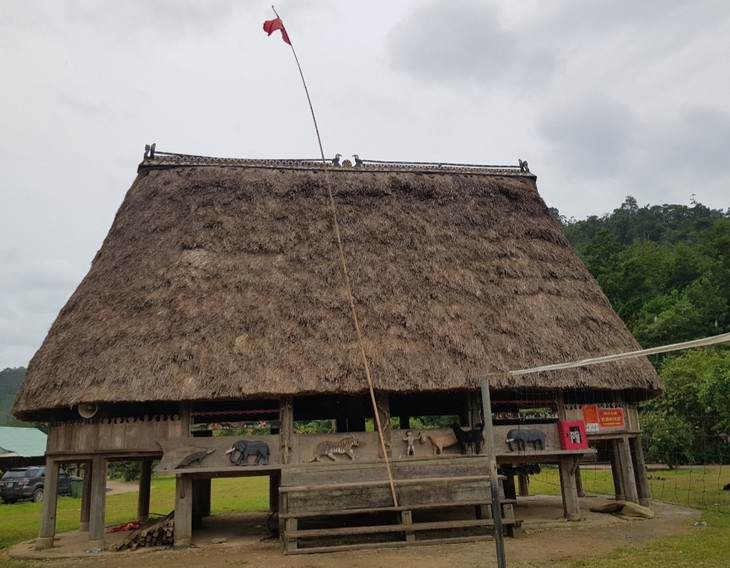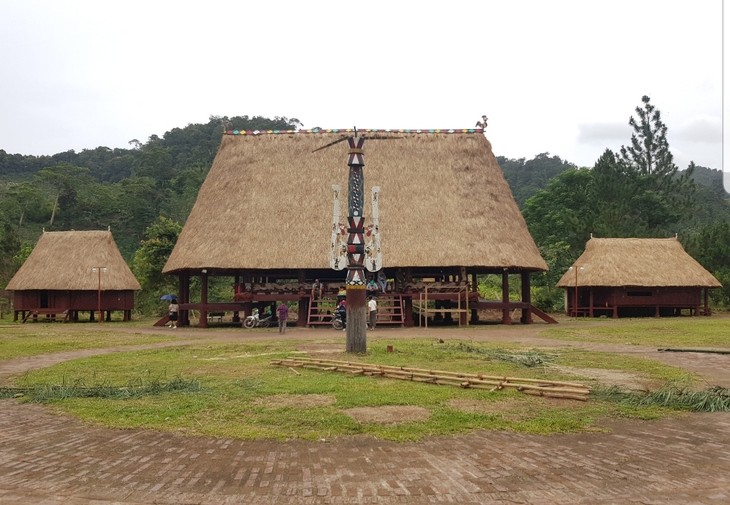The Guol House features the unique architecture and culture of the Co Tu. It’s a sacred and intimate symbol in the material and cultural life of the ethnic minority group, who live mainly in Thua Thien Hue and Quang Nam province in the Truong Son range.

Guol house of Por’ning hamlet, Lang commune, Tay Giang district, Quang Nam province (photo: Ngoc Anh)
“Guol” in the Co Tu language means community. When they settle in a new place, the first thing the Co Tu do is choose a location to build the Guol house, a symbol of the power and prosperity of the village.
Briu Po, the patriarch of Por’ning hamlet in Quang Nam province, said: ‘Every hamlet has a Guol house. The size of the house and engravings on it show the power of the hamlet. The house entrance looks to all directions as far as the eye can see."
In a Guol house, the more sculptures of objects and animals, the better, said Briu Po. "We carve whatever we want, but must have the following animals. First is the head of a buffalo because a buffalo is the most sacred 4-legged animal in Co Tu culture. There must be two roosters on the roof of the Goul house, representing 2-legged animals. A representative for the animal without legs is the python. The Co Tu believe that the python is a very strong and gentle animal, and it has an educational meaning for the villagers. There are several masks, which are used to ward off demons. The uglier the masks, the more frightening the devils are.”

The Co Tu traditional village in Tay Giang district, Quang Nam province (photo: Ngoc Anh)
As community tourism develops, the Guol House is becoming a tourist site where visitors can stay to learn more about the Co Tu’s life and culture, such as brocade weaving and other handicrafts. They can try to make musical instruments, play the gongs, and dance the “Tung tung Da dá” folk dance.
Guol is also a community center for holding traditional festivals, new rice ceremonies, and the twinning swearing-in ceremony. BhlingPhát, head of Pơr’ning hamlet, said: "The villagers gather at the Guol house to attend festivals or discuss community issues. Looking down from above, the Guol house looks like a tortoise shell. The roof is made of rattan leaves, palm leaves, and nipa leaves. The house is mainly made of wood. The sculptures of animals are to teach the next generation about wildlife and nature protection.”

Guol house in the Co Tu traditional village in Tay Giang district, Quang Nam province (photo: Ngoc Anh)
The Co Tu believe that Goul is a sacred place, the residence of gods and ancestors. When coming to Goul, people must not fight or quarrel. They must show unity and love, and be helpful to each other. PoloongPlenh, a resident of Tay Giang district, said: “When entering the Co Tu village, the first impression is Guol. Guol is the venue of solidarity and community events. All big and small festivals take place at Guol.”
Black and white are dominant colors of the paintings in the Guol house, such as the sun, the moon, and people playing gongs. On the walls they display musical instruments and farm tools. Guol is considered a cultural museum of the Co Tu.
A special feature of the Guol’s architecture is that it has only one main pillar, according to patriarch Briu Po.
“Community houses of the other groups often have many pillars. But the Guol house has only one main pillar at the center. It’s the symbol of united strength of the villagers. The Co Tu people believe that if all families and villagers unite as one, the village will never be disintegrated or destroyed. The village chief often reminds the villagers to stay united".
Ngoc Anh